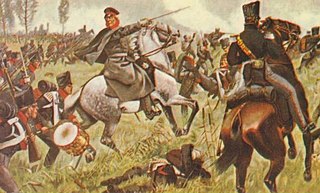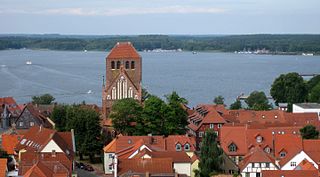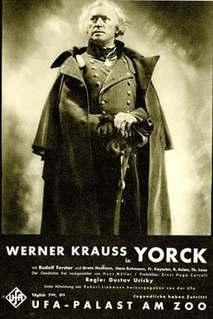
The Elbe is one of the major rivers of Central Europe. It rises in the Giant Mountains of the northern Czech Republic before traversing much of Bohemia, then Germany and flowing into the North Sea at Cuxhaven, 110 kilometres northwest of Hamburg. Its total length is 1,094 km (680 mi).
Herzogtum Lauenburg is the southernmost Kreis, or district, officially called Kreis Herzogtum Lauenburg, of Schleswig-Holstein, Germany. It is bordered by the district of Stormarn, the city of Lübeck, the state of Mecklenburg-Vorpommern, the state of Lower Saxony, and the city state of Hamburg. The district of Herzogtum Lauenburg is named after the former Duchy of Saxe-Lauenburg.

The Kreisau Circle (1940–1944) was a group of about twenty-five German dissidents in Nazi Germany led by Helmuth James von Moltke, who met at his estate in the rural town of Kreisau, Silesia. The circle was composed of men and a few women from a variety of backgrounds, including those of noble descent, devout Protestants and Catholics, professionals, socialists and conservatives. Despite their differences, the members of the Kreisau Circle found common interest in their opposition to Hitler's regime on moral and religious grounds. At their meetings, the circle discussed how they would reorganize the German government after the end of the Third Reich.

The Junkers were members of the landed nobility in Prussia. They owned great estates that were maintained and worked by peasants with few rights. These estates often lay in the countryside outside of major cities or towns. They were an important factor in Prussia and, after 1871, in German military, political and diplomatic leadership. The most famous Junker was Chancellor Otto von Bismarck. Bismarck held power in Germany from 1871 to 1890 as Chancellor of the German Empire. He was removed from power by Kaiser Wilhelm II.

Johann David Ludwig Graf Yorck von Wartenburg was a Prussian Generalfeldmarschall instrumental in the switching of the Kingdom of Prussia from a French alliance to a Russian alliance during the War of the Sixth Coalition. Ludwig van Beethoven's "Yorckscher Marsch" is named in his honor.
Count Yorck von Wartenburg may refer to:

Peter Graf Yorck von Wartenburg was a German jurist and a member of the German Resistance against Nazism. He studied law and politics in Bonn and Breslau from 1923 to 1926, gaining his doctorate in Breslau in 1927 and passing the civil service entrance examination for lawyers in Berlin in 1930. He married Marion Winter that same year.
Dabrun is a village and a former municipality in Wittenberg district in Saxony-Anhalt, Germany. Since 1 January 2010, it is part of the town Kemberg.

The Battle of Wartenburg took place on 3 October 1813 between the French IV Corps commanded by General Henri Gatien Bertrand and the Allied Army of Silesia, principally the I Corps of General Ludwig von Yorck. The battle allowed the Army of Silesia to cross the Elbe, ultimately leading to the Battle of Leipzig.
Hans Ludwig David Paul, Graf Yorck von Wartenburg was a German lawyer, writer and philosopher.
The Treaty of Kalisz was signed in Kalisz on 28 February 1813, between Russia and Prussia against Napoleon I. It marked the final changeover of Prussia onto the side against Napoleon.
Marion Gräfin Yorck von Wartenburg was a German activist, lawyer, jurist, judge and author. She was a resistance fighter against the Nazis and member of the Kreisau Circle.

SMS Yorck was the second and final member of the Roon class of armored cruisers built for the German Kaiserliche Marine as part of a major naval expansion program aimed at strengthening the fleet. Yorck was named for Ludwig Yorck von Wartenburg, a Prussian field marshal. She was laid down in 1903 at the Blohm & Voss shipyard in Hamburg, launched in May 1904, and commissioned in November 1905. The ship was armed with a main battery of four 21 cm (8.3 in) guns and had a top speed was 20.4 knots. Like many of the late armored cruisers, Yorck was quickly rendered obsolescent by the advent of the battlecruiser; as a result, her career was limited.

Oleśnica Mała is a village in the administrative district of Gmina Oława, within Oława County, Lower Silesian Voivodeship, in south-western Poland.

Yorck Boyen Insterburg was a German association football club from the city of Insterburg, East Prussia.

Duke Charles of Mecklenburg was a member of the House of Mecklenburg-Strelitz and a Prussian soldier who served in the Napoleonic Wars. From 1827 until his death he was President of the Prussian State Council.

The Battle of Waren-Nossentin on 1 November 1806 saw soldiers of the Kingdom of Prussia led by August Wilhelm von Pletz and Ludwig Yorck von Wartenburg fight a rear guard action against troops of the First French Empire commanded by Marshal Jean-Baptiste Bernadotte. Though forced to give ground, the Prussians successfully kept the French from inflicting serious loss or cutting off any units in this War of the Fourth Coalition action. Waren lies on the northern end of Lake Müritz, about 70 kilometres (43 mi) southeast of Rostock. Nossentin is a small village on the Fleesen See about 15 kilometres (9 mi) due west of Waren.

Yorck is a 1931 German war film directed by Gustav Ucicky and starring Werner Krauss, Grete Mosheim and Rudolf Forster. It portrays the life of the Prussian General Ludwig Yorck von Wartenburg, particularly his refusal to serve in Napoleon's army during the French Invasion of Russia in 1812. It was a Prussian film, one of a cycle of films made during the era that focused on Prussian history.

The Combat of Rosslau was fought in the War of the Sixth Coalition on 29 September 1813, near Rosslau, Germany. Michel Ney attacked the Swedish bridgehead at the Elbe, to stop the Army of the North from crossing the river. The Swedish commander Johan August Sandels counterattacked and chased the French for 5 km (3 mi) before being forced to retire himself. About 350 Swedes were dead and wounded while the French had at least 1,500, according to Swedish sources. The battle had no strategic effects, but it was one of very few times in the war that a Swedish force was fully committed in battle.

















